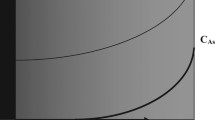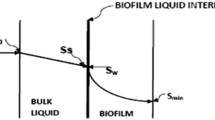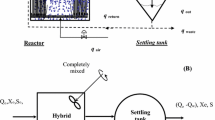Abstract
Dueck’s mathematical model of biofilm is discussed. This model is also generalized to cover all substratum types. This system is based on a nonlinear reaction–diffusion equation that includes a nonlinear term related to square law of microbial death rate. In this paper, the analytical expression of the substrate consumption and flux in a biofilm is obtained by solving the nonlinear differential equation using the Taylor series and the modified Adomian decomposition method. Comparing the results obtained with the numerical method and limiting case results shows the validity and usefulness of these techniques.







Similar content being viewed by others
REFERENCES
Christensen, B.E. and Characklis, W.G., Physical and chemical properties of biofilms, Biofilms, Characklis, W.G. and Marshall, K.C., Eds., New York: Wiley, 1990, pp. 93–130.
Frank-Kamenetskii, D.A., Diffuziya i teploperedacha v khimicheskoi kinetike (Diffusion and Heat Transfer in Chemical Kinetics), Moscow: Nauka, 1987, 3rd ed.
Poltorak, O.M., Pryakhin, A.N., and Shaitan, K.V., A general approach to solving kinetic problems, Vestn. Mosk. Univ., Ser. 2: Khim., 1975, no. 5, pp. 536–543.
Williamson, K. and McCarty, P.L., A model of substrate utilization by bacterial films, J. - Water Pollut. Control Fed., 1976, vol. 48, no. 1, pp. 9–24.
Rittmann, B.E. and McCarty, P.L., Evaluation of steady state biofilm kinetics, Biotechnol. Bioeng., 1980,vol. 22, no. 11, pp. 2359–2373.
Wimpenny, J.W. and Colasanti, R., A more unifying hypothesis for biofilm structures – A reply, FEMS Microbiol. Ecol., 1997, vol. 24, no. 2, pp. 185–186.
Picioreanu, C., Van Loosdrecht, M.C.M., and Heijnen, J.J., Mathematical modeling of biofilm structure with a hybrid differential-discrete cellular automaton approach, Biotechnol. Bioeng., 1998, vol. 58, no. 1, pp. 101–116.
Picioreanu, C., Kreft, J.H., and Van Loosdrecht, M.C.M., Particle-based multidimensional multispecies biofilm model, Appl. Environ. Microbiol., 2004, pp. 3024–3040.
Noguera, D.R., Okabe, S., and Picioreanu, C., Biofilm modeling: Present status and future directions, Water Sci. Technol., 1999, vol. 39, no. 7, pp. 273–278.
Kreft, J.U., Picioreanu, C., Van Loosdrecht, M.C.M., and Wimpenny, J.W.T., Individual-based modelling of biofilms, Microbiology, 2001, vol. 147, no. 11, pp. 2897–2912.
Riedel, K., Steidle, A., Eberl, L., Wu, H., Geisenberger, O., Molin, S., and Givskov, M., N-acylhomoserine-lactone-mediated communication between Pseudomonas aeruginosa and Burkholderiacepacia in mixed biofilms, Microbiology, 2001, vol. 147, no. 12, pp. 3249–3262.
Morgenroth, E., Eberl, H.J., Van Loosdrecht, M.C.M., Noguera, D.R., Pizarro G.E., Picioreanu C., and Wanner, O., Comparing biofilm models for a single species biofilm system, Water Sci. Technol., 2004, vol. 49, nos. 11–12, pp. 145–154.
Laspidou, C.S. and Rittmann, B.E., Modeling the development of biofilm density including active bacteria, inert biomass, and extracellular polymeric substances, Water Res., 2004, vol. 38, nos. 14–15, pp. 3349–3361.
Hermanowicz, S.W., A model of two-dimensional biofilm morphology, Water Sci. Technol., 1998, vol. 37, nos. 4–5, pp. 219–222.
Hermanowicz, S.W., A simple 2D biofilm model yields a variety of morphological features, Math. Biosci., 2001, vol. 169, no. 1, pp. 1–14. https://doi.org/10.1016/S0025-5564(00)00049-3
Min’kov, L.L., Pyl’nik, S.V., and Dueck, J.H., Steady-state problem of substrate consumption in a biofilm for a square law of microbial death rate, Theor. Found. Chem. Eng., 2006, vol. 40, no. 5, pp. 496–502. https://doi.org/10.1134/S004057950605006X
Dueck, J.H., Diffusion-kinetic rate of substrate consumption in a biofilm, Theor. Found. Chem. Eng., 2005, vol. 39, no. 6, pp. 573–578. https://doi.org/10.1007/s11236-005-0119-z
Muthukaruppan, S., Eswari, A., and Rajendran L., Mathematical modelling of a biofilm: The Adomian decomposition method, Nat. Sci., 2013, vol. 5, no. 4, pp. 456–462.
Adomian, G., A review of the decomposition method in applied mathematics, J. Math., Anal. Appl., 1988, vol. 135, pp. 501–544.
Liao, S.J., On the homotopy analysis method for nonlinear problems, Appl. Math. Comput., 2007, vol. 147, pp. 499–513.
Liao, S.J., Comparison between the homotopy analysis method and homotopy perturbation method, Appl. Math. Comput., 2005, vol. 169, pp. 1186–1194.
He, J.H., Homotopy perturbation technique, Comput. Methods Appl. Mech. Eng., 1999, vol. 178, nos. 3–4, pp. 257–262.
He, J.H., A coupling method of a homotopy technique and a perturbation technique for non-linear problems, Int. J. Non-Linear Mech., 2000, vol. 35, no. 1, pp. 37–43.
Saravanakumar, R., Pirabaharan, P., Abukhaled, M., and Rajendran, L., Theoretical analysis of voltammetry at a rotating disk electrode in the absence of supporting electrolyte, J. Phys. Chem. B, 2020, vol. 124, no. 3, pp. 443–450.
He, J.H., Variational iteration method for autonomous ordinary differential systems, Appl. Math. Comput., 2000, vol. 114, nos. 2–3, pp. 115–123.
Odibat, Z. and Momani, S., A generalized differential transform method for linear partial differential equations of fractional order, Appl. Math. Lett., 2008, vol. 21, no. 2, pp. 194–199.
Saranya, K., Mohan V., and Rajendran, L., Steady‑state concentrations of carbon dioxide absorbed into phenyl glycidyl ether solutions by residual method, J. Math. Chem., 2020, vol. 58, pp. 1230–1246.
Nirmala K., Manimegalai, B., and Rajendran, L., Steady-state substrate and product concentrations for Non-Michaelis–Menten kinetics in an amperometric biosensor – Hyperbolic function and Padé approximants method, Int. J. Electrochem. Sci., 2020, vol. 15, pp. 5682–5697.
Miletics, E. and Molnárka, G., Taylor series method with numerical derivatives for initial value problems, J. Comput. Methods Sci. Eng., 2004, vol. 4, nos. 1–2, pp. 105–114.
Rentrop, P., A Taylor series method for the numerical solution of two-point boundary value problems, Numer. Math., 1978, vol. 31, no. 4, pp. 359–375.
Miletics, E. and Molnárka, G., Taylor series method with numerical derivatives for numerical solution of ODE initial values problems, Hung. Electron. J. Sci: Appl. Numer. Math., 2003, pp. 1–16.
Georgiev, S.G. and Erhan, I.M., The Taylor series method and trapezoidal rule on time scales, Appl. Math. Comput., 2020, vol. 378, pp. 1–13.
Groza, G. and Razzaghi, M., A Taylor series method for the solution of the linear initial–boundary-value problems for partial differential equations, Comput. Math. Appl., 2013, vol. 66, no. 7, pp. 1329–1343.
Usha Rani, R. and Rajendran, L., Taylor’s series method for solving the nonlinear reaction-diffusion equation in the electroactive polymer film, Chem. Phys. Lett., 2020, vol. 754, pp. 1–30.
Barrio, R., Rodriguez, M., Abad, A., and Blesa, F., Breaking the limits: The Taylor series method, Appl. Math. Comput., 2011,vol. 217, no. 20, pp. 7940–7954.
Rodríguez, M. and Barrio, R., Reducing rounding errors and achieving Brouwerʼs law with Taylor Series Method, Appl. Numer. Math., 2012, vol. 62, no. 8, pp. 1014–1024.
Shiraishi, F., Egashira, M., and Iwata, M., Highly accurate computation of dynamic sensitivities in metabolic reaction systems by a Taylor series method, Math. Biosci., 2011, vol. 233, no. 1, pp. 59–67.
Wazwaz, A.M., A comparison between Adomian decomposition method and Taylor series method in the series solutions, Appl. Math. Comput., 1998, vol. 97, no. 1, pp. 37–44.
He, J.H., Taylor series solution for a third order boundary value problem arising in Architectural Engineering, Ain Shams Eng. J., 2020, vol. 11, no. 4, pp. 1411–1414. https://doi.org/10.1016/j.asej.2020.01.016
He, C.H., Shen, Y., Ji, F.Y., and He, J.H., Taylor series solution for fractal Bratu-type equation arising in electrospinning process, Fractals, 2020, vol. 28, pp. 1–8. https://doi.org/10.1142/S0218348X20500115
Chitra Devi, M., Pirabaharan, P., Abukhaled, M., and Rajendran, L., Analysis of the steady-state behavior of pseudo-first-order EC-catalytic mechanism at a rotating disk electrode, Electrochim. Acta, 2020, vol. 345, no. 10, article no. 136175. https://doi.org/10.1016/j.electacta.2020.136175
Wik, T., On modeling the dynamics of fixed biofilm reactors with focus on nitrifying trickling filters, PhD Thesis, Gothenburg: Chalmers Univ. of Technology, 1999.
Adomian, G., Solving Frontier Problems of Physics: The Decomposition Method, Dordrecht: Kluwer Academic, 1994.
Al-Hayani, W. and Casasus, L., The Adomian decomposition method in turning point problems, J. Comput. Appl. Math., 2005, vol. 177, pp. 187–203.
Wazwaz, M., Adomian decomposition method for a reliable treatment of the Bratu-type equations, Appl. Math. Comput., 2005, vol. 166, pp. 652–663.
Hasan, Y.Q. and Zhu, L.M., Solving singular boundary value problems of higher-order ordinary differential equations by modified Adomian decomposition method, Commun. Nonlinear Sci. Numer. Simul., 2009, vol. 14, no. 6, pp. 2592–2596. https://doi.org/10.1016/j.cnsns.2008.09.027
ACKNOWLEDGMENTS
We are very grateful to the reviewers for their comments and suggestion. The authors are also thankful to Shri J. Ramachandran, Chancellor, Col. Dr. G. Thiruvasagam, Vice-Chancellor, Dr. M. Jayaprakashvel, registrar Academy of Maritime Education and Training (AMET), Deemed to be University, Chennai, for their constant encouragement.
Author information
Authors and Affiliations
Corresponding author
Ethics declarations
The authors declare that they have no conflicts of interest.
Appendices
APPENDIX A
Analytical solution of nonlinear reaction Eq. (11)using the TSM method. The steady-state nonlinear equation (11) can be written as follows:
By differentiating the above Eq. (A1) successively with respect to “x”, we get the following results.
The boundary condition (12) can be written as
Using this condition in the above Eqs. (A1) to (A4), we get
The concentration of substrates using the Taylor series is
Substituting Eqs. (A5) to (A10) into Eq. (A11), we obtain Eq. (19) in the text.
APPENDIX B
Analytical solution of nonlinear reaction Eq. (14)using the boundary conditions ((15) and (16)) by the modified Adomian decomposition method. In this Appendix, we indicate how Eq. (24) is derived. In order to solve Eq. (14) by means of the modified Adomian decomposition method [46]. We write Eq. (14) in the operator form
where \(L\) and \(N\) are linear and nonlinear terms of Eq. (14). Here, \(N(S) = {{\left( {\frac{S}{{1 + S}}} \right)}^{2}}.\) The operator for spherical substratum is defined as [46]
Applying the inverse operator [46]
on both sides of Eq. (B1) yields
where \(A\) and \(B\) are constants of integration. Let
In view of Eqs. (B4) to (B6) gives
The zero elements is defined as
and the remaining components as the recurrence relation \({{S}_{{i + 1}}}\left( x \right) = \delta {{L}^{{ - 1}}}{{A}_{i}},\) \(i \geqslant 0\)
where \({{A}_{i}}(x) = \frac{1}{{i!}}\frac{{{{d}^{i}}}}{{d{{\lambda }^{i}}}}N\)\({{\left( {\sum\limits_{n = 0}^\infty {{{\lambda }^{i}}{{S}_{i}}} } \right)}_{{\lambda = 0}}}\) are the Adomian polynomials of \({{S}_{1}},{{S}_{2}},...{{S}_{i}}\). We can find \({{A}_{i}}\) as follows:
The remaining polynomials can be easily generated and so on
Adding Eqs. (B11) to (B13), we get the concentration of substrate in the biofilm (Eq. (24)).
NOTATION
L f | biofilm thickness, m |
S f | concentration of substrate in the biofilm, g/m3 |
S 1 | concentration of substrate outside the biofilm, g/m3 |
D f | diffusion coefficient within the biofilm, m2/s |
z | distance from biofilm, m |
ψ | flux of substrate, g/m2 d |
b | microbial death constant, m3/g d |
K | Michaelis-Menten constant, g/m3 |
X f | position of an occupied grid cell above the substratum within the grid, g/m3 |
q | rate constant of substrate consumption, d–1 |
Y | yield per unit amount of substrate consumed in biofilm, g/m3 |
R | radius of the sphere, m |
S | dimensionless concentration of substrate in the biofilm |
S L | dimensionless concentration of substrate outside the biofilm |
x | dimensionless distance from the biofilm |
δ | dimensionless biofilm thickness |
m | dimensionless constant |
SUBSCRIPTS AND SUPERSCRIPTS
f | film |
L, 1 | solution |
Rights and permissions
About this article
Cite this article
Jeyabarathi, P., Kannan, M. & Rajendran, L. Approximate Analytical Solutions of Biofilm Reactor Problem in Applied Biotechnology. Theor Found Chem Eng 55, 851–861 (2021). https://doi.org/10.1134/S0040579521050213
Received:
Revised:
Accepted:
Published:
Issue Date:
DOI: https://doi.org/10.1134/S0040579521050213




